From farmgate to retail shelves there are numerous interconnected factors that are required to function properly together to produce the milk that eventually makes it into our homes.
Immigrant Labor could trigger a chain reaction
Like many other important steps in dairy production, labor is one piece that, if affected, has a corresponding impact on all the other pieces. There are concerns ranging from sourcing dairy labour from immigrants to documentation, to wages to political implications. A major concern relates to what would happen if immigrant labor was completely taken away. An updated survey called for by the National Milk Producers Federation and produced by Texas AgriLife Research at Texas A&M University, predicts serious repercussions if there was to be a loss of immigrant labor on American dairy farms.
Report Findings (Year)
The report shows that of the 150,418 employees working on U.S. dairy farms in 2013, 51 percent of them, or 76,968, were immigrants. The conclusion drawn by researchers is that losing these workers would double retail milk prices at a total cost to the U.S. of more than $32 billion dollars. The report suggests that loss of immigrant labour would raise the price of a gallon of milk which sold for $3.37 in June to a whopping $6.40. On top of this — at the other end of the chain … it could also cause the loss of one-in-six dairy farms. (Read more: Losing Immigrant Workers on Dairy Farms Would Nearly Double Retail Milk Prices)
Rising Numbers of Immigrant Labor
Since an original survey of immigrant labor was done in 2009, there has been significant changes in the numbers of immigrants working on dairy farms. The updated survey shows an increase of 20,000 immigrant workers (35%) in the intervening six years and 27% more of the milk supply coming from farms with immigrant labor.
Beyond the basic statistics, there is concern over documented and undocumented foreign-born workers.
Eighty percent of those who responded to the survey have concerns about immigration raids or unemployment audits due to their lack of confidence in immigrant worker’s employment documents.
Misconceptions about Immigrant Labor
Some believe that immigrants take jobs away from Americans. According to NMPF’s board chairperson and Missouri dairy farmer Randy Mooney, this is simply not true. He explains that the average hourly wages offered are $11.54 and thus are well above the minimum wage of $7.25. Nevertheless even with the three plus dollar increased wage, dairy farmers have been unsuccessful in getting Americans to do these jobs.
The Domino Effect of Failure to Act On Immigration Reform
Not having a reliable, current labor force means an inability to ensure an effective future workforce. Likewise, researchers explain that milk sales also support many more jobs beyond the farm than on the farm. In Canada, the phrase “Milkle-Down Affect” (http://www.milkledowneffect.ca/ ) has been coined to raise discussion on how dairying affects not only the local community but has much wider impacts. The immediate loss would be from the fact that there would be 76,968 fewer people working on dairy farms. A total loss of immigrant labor on dairy farms would also mean the loss of jobs outside the farm. What is often overlooked is the loss of jobs related to dairying. Those kinds of jobs add up to a loss totaling 131,240 jobs. Almost 200,000 jobs and the numbers keep mounting!
There would also be repercussions beyond the obviously reduced farm milk sales. Losses would be incurred because of the reduced purchasing power, not only of dairy farms but now from the unemployed workers. As well, the lost sales would extend beyond the farm to businesses that support dairy farms, such as feed and equipment dealer, veterinarians, and feed suppliers. . In the bigger dairy picture, there would be an estimated loss of 25% of the national dairy herd and national milk production. More than 7,000 farms would close
Immigrant Labor is a Hot-Button Election Issue
Discerning observers of the dairy industry feel that Congress urgently needs to address this issue. Comprehensive immigration reform is necessary for dairy operations to adequately meet their labor requirements. Jim Mulhern, who is the NMPF President and Chief Executive Officer, points out, “Farms that rely on hired foreign workers need their current labor force as well as an effective program to ensure an adequate future workforce.” He warns that the dangers don’t stop at a reduced workforce. “The lack of a reliable source of workers is causing farmers to second-guess decisions to expand,” he said. “That’s economic activity that’s lost to both rural and urban communities — all because Washington won’t act on immigration reform.”
A Catch 22 Situation
This is definitely a problem that needs to be faced with proper action. It would be wrong, however, if the action taken had negative repercussions for every stakeholder involved.
- Dairy farmers need a labor pool to draw upon.
- Current immigrant workers rely on the income they are earning.
- American workers need to be encouraged to work in agriculture.
- Dairy consumers have the right to reasonably priced access to healthy milk products.
- It seems that we are coming pretty close to throwing out the baby with the bathwater. The simple solution of throwing out immigrant labor could mean the end of one-in-six dairy farms.
Solving labor problems needs a multi-pronged approach if the solution is going to be effective.
The Bullvine Bottom Line
Sometimes we become complacent in North America because we don’t appear to have the challenges that our dairy peers in the UK and Europe have (see “Cheap Milk Flooding the Grocery Aisles”). However, while the root causes of disruption may differ, the result could be the same – an irreparably damaged dairy industry.
Get original “Bullvine” content sent straight to your email inbox for free.


















Leave a Reply
You must be logged in to post a comment.